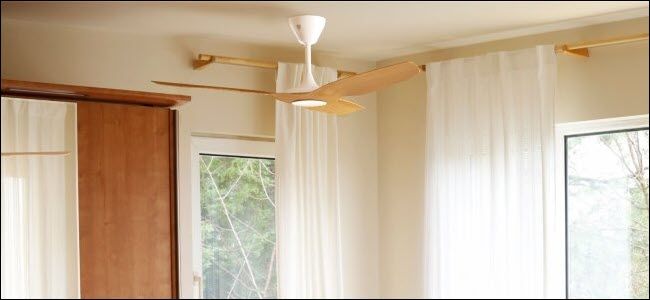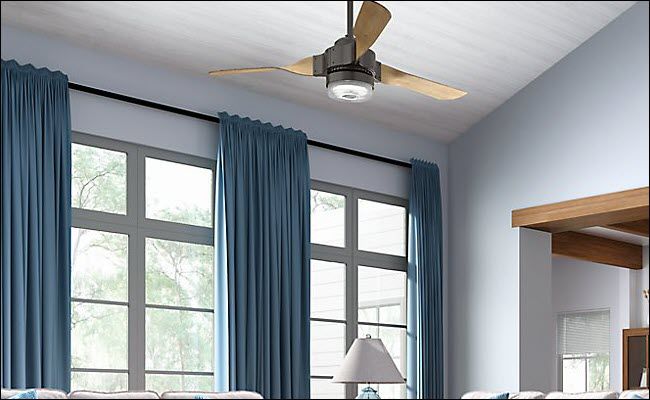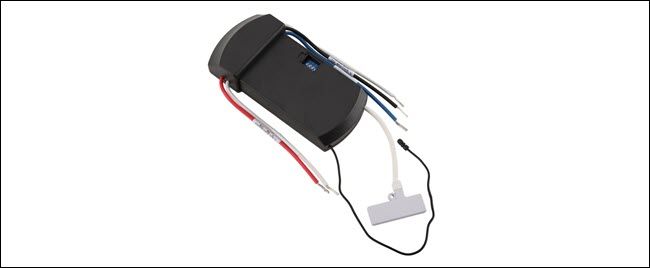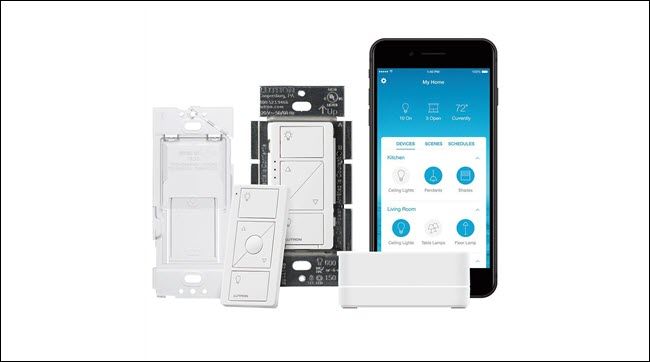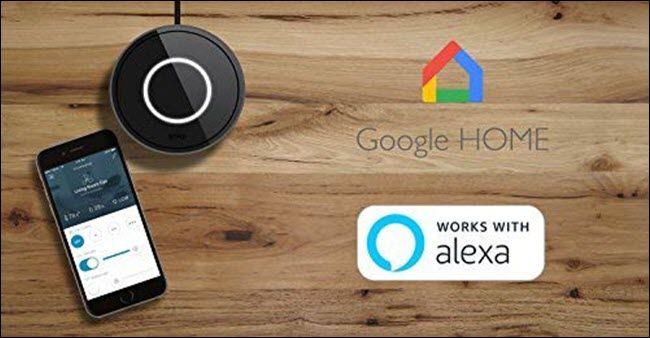Quick Links
A smarthome promises freedom from wall switches and pull chains. Instead, you get voice control and powerful automation. That's how it works for smart light bulbs, anyway. Why not make your home's ceiling fans smart, too?
Smart fans are another great convenience for the home. With a connected fan, not only do you gain voice and remote control, but you can also add schedules and routines. You can add smart fans to your home in several ways: install a new one, convert an existing "dumb" fan, install a smart fan switch, or add a smart bridge for fans.
The Expensive Option: Buy a New Smart Fan
If you want a fan that integrates easily into your existing smarthome system, installing a new smart fan is the easiest option. Smart fans typically come in either a Wi-Fi or Zigbee format. If you choose a Wi-Fi fan, like those from Hunter or Haiku, you won't need a hub.
You still typically get a standard Infrared (IR) remote control, plus access through a smartphone or tablet app. Wi-Fi fans usually offer Alexa and Google Assistant integration, with voice control of both the integrated lights and the fan. You'll need to install a dedicated app on your smartphone or tablet. And, of course, you run the risk of interference if you have too many Wi-Fi devices on your network.
ZigBee fans, however, do require a smart hub. The most prevalent offerings, from Gardiner and Hampton Bay, are designed specifically for Wink hubs. If you have multiple ZigBee smart home devices, they'll form a mesh network with the ZigBee fan for better range. Unfortunately, while they do have Alexa and Google Assistant integration, that doesn't usually include voice control of the fan---the voice assistants can only turn the integrated light on and off.
If you've installed a fan with an IR remote before, installing a smart fan follows the same process. You wire in an IR module that also includes either Wi-Fi or ZigBee radios as you install the fan.
The biggest drawback---besides having to install the fans---is the expense. Smart fans range from $130 to $640. It also introduces an additional point of failure---our smart fan's ZigBee radio failed after four months, and neither the manufacturer nor the store wanted to fix it. The fan still works but as a standard dumb fan.
Turn Your Current "Dumb" Fan Into a Smart Fan
If you don't want to buy all new fans, it might be possible to convert those you already have. If your fan already has an IR module, you could replace it with an adapter with Wi-Fi or Zigbee radios.
You'll run into the same positives and negatives you would with a genuine Wi-Fi or Zigbee fan. The ZigBee Wink controller still doesn't allow your voice assistant to control the fan speeds, for instance. But at $50 to $70, adding the radios to your existing fan is far less expensive than buying an entirely new fan.
To add a smart module to your existing fan with IR, you take the fan apart, remove the IR module, and then replace it with the smart module. Typically, they're the same shape and size, but with an extra antenna.
If your fan doesn't include an IR remote, you might still be able to add a smart module. But you should take your fan apart first and doublecheck that you have plenty of room in the motor housing for an extra device. You'll want to look at where the wiring from your fan connects to the wiring from your home.
Replace Your Fan's Wall Switch with a Smart One
If you control your fans with a dedicated wall switch (often found next to a light switch), you could bypass buying a new fan or converting an existing one, altogether. Instead, you can replace your current dumb fan switch with a smart fan switch. Smart fan switches come in Wi-Fi (Lutron Caseta), ZigBee (GE), and Z-Wave (also GE) models. They typically range between $45 and $60. Often, they need a hub to integrate into your smarthome system, that includes some Wi-Fi switches, like Lutron's, so that adds to the cost, too, if you don't already have the hub.
Smart fan switches work a lot like smart light switches. You have to replace your current switch with the smart switch. Typically, the smart version is larger, and some require a neutral wire. So, you'll want to doublecheck that you have both the necessary space and wiring. If you're uncomfortable working with your home's wiring, consider hiring an electrician. And if you rent rather than own your home, you should make sure you're allowed to install the switch.
Lutron Caseta switches have an optional wireless remote that works with the wired switch. You can mount that elsewhere for easy control in multiple locations.
Once installed, you can continue to use your fan switch as you always did. But you can also connect to the switch through an app, Alexa, or Google Assistant.
Add a Smart Bridge to Avoid Any Wiring
You don't have to install a new fan, wire in a new receiver, or replace a switch. If your existing fan has an IR remote, you can use a bridge to control it. If you already own a Logitech Harmony, you can program it to work with most IR devices.
You could try typing your fan and model number into the Logitech Harmony compatibility site to see if it's supported natively (five of the fans we tried weren't). Even if your fan isn't listed, you can manually program an IR remote into Logitech Harmony. Once you pair your fan with Harmony, you can control it through the Logitech app or use basic on and off voice commands with Alexa or Google Assistant.
For an easier and less expensive option, you might consider the Bond Smart Bridge, which goes for $100. Bond designed its bridge specifically to control fans, and it also works with electric fireplaces and some air conditioners. Setup is easy---while the bridge is in scanning mode, you point your existing IR remote at it and hold the power button. Bond checks the code against its database and, if it finds a match, it automatically programs the rest. The bridge acts as an IR blaster so that it can replace your remote.
Bond includes an app, but it is, admittedly, not very stable. In our experience, it often successfully sends a control command but then complains the command failed. But, thanks to both Alexa and Google integration, you don't need the app after pairing. You can use the Google or Alexa app instead, or voice commands. And with Bond, nearly any function your remote can do, voice can do. If you properly grouped and named your devices, you can say, "Turn on the fan" or "Turn the fan to 60 percent" when an Echo or Google Home is in the same room as the fan.
IR blaster bridges, like Logitech and Bond, aren't perfect though. If a physical switch controls your fan, turning that off prevents the bridges from working correctly---just like a smart bulb can't work when the light switch is off.
Fan smart bridges also don't track the current power state. So, if you use a voice command to turn off all devices in a room, your smart bridge might send the Off command even when the fan is already off. Since many IR devices use the same command for on and off, that means while everything else in the room turns off, your fan and light might turn on.
But a bridge might be the least intimidating method to convert your existing fan into a smart fan. If you can install an Echo and pair a smart bulb, you can probably install an IR smart bridge and pair a fan.
If your fan doesn't have an IR remote, you can either add a universal IR module and use that with a smart fan, or install one of the above smart radios.

